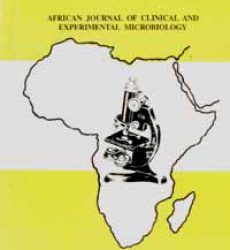Abstract
Objectives: The aim of this retrospective study is firstly to analyse the results of the HIV antibodies screening and confirmatory tests in order to determine the seroprevalence rate of HIV infection among this prospective service personnel. Secondly, to compare the prevalence rates between the males and females. Finally, to compare the seroprevalence rate in 2003 with that of 2002 among similar group.
Methodology: A total of 900 consecutive prospective recruits were screened for HIV antibodies using double technique. Confirmatory tats were then performed on positive sera using Immunoconfirmatory kits. Chi square was used to analyze the results. Of the 900 tested 8l7 are males while 83 are females.
Results: The prevalence is 1.4%. Overall in 2002, out of 431 officers screened in both groups, 8 (1.86%) were positive for HIV antibodies comprising 5 men (1.16%) and 3 women (0.69%). In 2003, out of a total of 900 recruits tested for HIV seropositivity, 13 (1.4%) were found to be seropositive with a 95% confidence interval of 1.0% to 1.8%.
Discussion and Conclussion: Our results show a seroprevalenee of 1.44% among members of this security outfit and it is quite low compared to the national average of 5%. Our findings are low compared to seroprevalenee rata among ANC clients, Tb patients, STD clients and blood donors. However, it is comparable to 1.7% among another group of paramilitary in 2002, 1.4% among people with leprosy and 1.8% in Jigawa State sentinel survey. Health education is advised.
African Journal of Clinical and Experimental Microbiology Vol. 7(2) 2006: 101-105
Download full journal in PDF below
HIV seroprevalence rates among prospective service personnel in a Nigerian security facility

